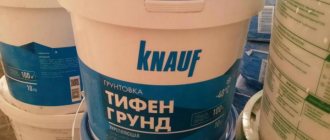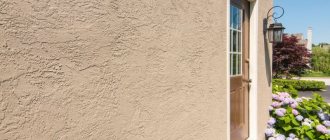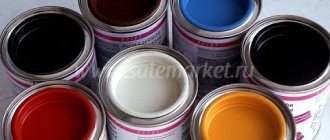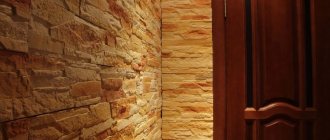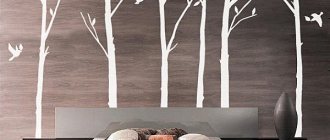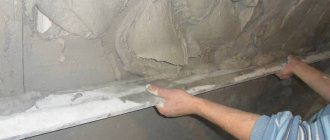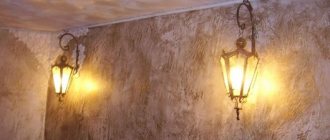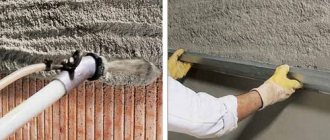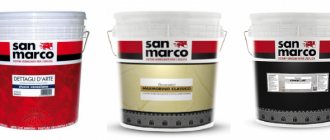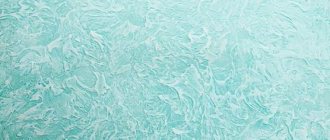Types of special plasters: a brief overview of special-purpose materials
In addition to the usual leveling and decorative finishing compounds, there are special-purpose compounds. Their cost is always higher and they are designed to solve specific problems. What are special plasters used for? For example, to increase sound insulation, to make surfaces resistant to water, and so on.
Waterproofing plaster as a type of special finishing
This solution belongs to the category of surface waterproofing. Its task is to prevent moisture from entering the thickness of the wall or foundation. The mixture is used for finishing both interior spaces and facades.
There are 2 main types considered:
- cement-sand - much more familiar and popular;
- asphalt plaster - suitable only for exterior finishing.
Cement-sand composition
Its obvious difference from the abundance of other mixtures of the same kind is its high density.
For waterproofing, a layer of a few mm – up to 3 cm – is sufficient. High density causes low porosity, which ensures the appearance of hydrophobic properties. A solution is made from non-shrink Portland cement, sifted quartz sand - river or quarry, and water. The ratio of cement and sand is 1:2. It is imperative to use a variety of additives:
- ferric chloride – significantly enhances waterproofing qualities;
- sulfate-yeast mash - ensures rapid setting of such a mixture;
- plasticizing additives that increase the level of moisture resistance - soap naft, oleates;
- sealants - stone flour, cerolite, bitumen emulsions, coal flour;
- components that increase adhesion to certain types of materials.
Waterproofing plaster can be used as a leveling plaster. It fully allows for further finishing - with tiles, for example. In this case, you need to apply several layers. The thickness of 1 layer is 6–10 mm, the thickness of the colloidal layer is 3–7 mm. The plaster sets within 30 minutes for regular plaster, and 40 minutes for colloidal plaster, so plastering does not take much time.
At home, the waterproofing mixture solution is prepared in the usual way, but mixing is best done in a concrete mixer: here, too, high uniformity of the composition is very important.
Scope of its application
Plaster waterproofing is suitable for processing:
- foundations - if there is no shrinkage;
- basements - that is, processing foundations from the inside;
- damp rooms - waterproofing plaster is used in the bathroom, for example;
- facades and plinths;
- parking lots, any external structures that need protection from moisture;
- premises where direct contact with water is expected - swimming pools, and this means not only the walls of the room, but also the bowl of the reservoir itself.
Characteristics and properties
Dry plaster waterproofing has many advantages:
- gives the surface high hydrophobicity, and this quality is maintained under water pressure at a depth of up to 5 m;
- very economical - a layer thickness of 3–7 mm is enough to ensure reliable insulation;
- at the same time, leveling with its help is allowed;
- excellent mechanical resistance;
- withstands high temperature changes;
- Decorative finishing is possible - tiles, paint;
- absolutely safe - the mixture is used for waterproofing drinking water tanks.
- requires wall preparation - not just sealing cracks, but also priming, creating sufficient roughness;
- Use only on fixed surfaces is allowed, and only after shrinkage has completed. Otherwise, the layer will crack. This is the main disadvantage of plaster waterproofing.
Read more about the price of waterproofing plaster.
The video below will tell you about plastering and waterproofing a bathroom:
Cost of materials
Since the basis of the material is cement and sand, the cost of the material is quite affordable. At the same time, it is necessary to take into account the economical consumption of waterproofing plaster - 1.5 kg per 1 sq. m.
- Waterproofing plaster of the famous brand Ceresit will cost 750–820 rubles. per package of 25 kg. The mixtures are distinguished by very high mortar performance in terms of compressive and bending strength.
- Waterproofing plaster Consolit 540 costs much less - from 230 rubles. per package of 25 kg.
- Waterproofing plaster from MAGMA will cost 308 rubles. for 25 kg.
- Material from the EU company costs from 449 rubles. Recommended for use when leveling and insulating.
- Waterproofing plaster "Monolith" is intended for insulation of basements, attics, swimming pools and laundry rooms. Costs from 200 rub. per package.
Asphalt composition
This coating includes several layers of asphalt mastic or a mixture of emulsion mastic with a special paste that enhances viscosity. The solution is intended for waterproofing the base, foundation, basement. Apply to both horizontal and vertical surfaces.
- Hot plaster is heated to 180 C before application. The solution guarantees a very high degree of waterproofing, but special equipment is required for heating and application.
- The cold mixture is applied manually or by machine. It’s easier to work with, especially in interior spaces.
Plastering the interior walls of a house with your own hands
This process includes several basic procedures: marking and priming, installation of beacons, plastering, grouting.
Surface marking and priming
Using a plumb line or water level, find uneven areas and mark them with a marker. Mark the wall for installation of beacons. You should start from the corner, retreating 0.3 m and drawing a vertical line. The distance from one beacon to another should be 1.6 m.
At a distance of 15 cm from the floor and ceiling, make holes using a drill , insert dowels with self-tapping screws into them and pull the rope. The same must be done from the other edge of the wall.
Treat the surface with 1–2 primer layers to improve adhesion. After the primer has dried, you can continue marking. Using self-tapping screws, secure several vertically stretched ropes as in the photo above, which will serve as guides when leveling the wall.
Do you know why you need to prime the walls before plastering? Detailed information is here.
Installation of beacons
The approximate length of the beacons is 2.4 m. Prepare a gypsum solution for fixing the beacons, which should be similar in consistency to cottage cheese. This will allow it not to fall off the spatula . The mixture is applied along the drawn line, after which the beacon is pressed into it so that it does not reach the screw heads.
Using a level, check that the beacon is installed correctly . If necessary, adjust its position, then unscrew the screws from the wall.
Acoustic finishing
Its peculiarity is its high porosity. Air-filled pores provide not only thermal insulation properties, but also excellent sound insulation properties.
The composition of this mixture
Today, several types of solutions are best known.
- From cement and pumice - sifted pumice or vermiculite with a granule size of no more than 3 mm is combined with cement in a ratio of 4:1. Mix the components dry and then dilute with water. This composition is applied after cement plaster: this increases adhesion and noise insulation properties. The layer thickness is 25 mm, the surface is not rubbed down - finishing, especially painting, is undesirable because it reduces sound insulation.
- From gypsum and slag - sifted slag with a grain diameter of no more than 2 mm is mixed with ready-made gypsum milk. The plaster is applied to the primed surface without grouting. This coating is afraid of water.
- From cement and slag - sifted cement and slag with a granule size of 3–5 mm are mixed dry in a ratio of 1:4 and mixed with water. The residue after sifting through a 3 mm sieve can be used as a compacting agent. Before application, the wall or ceiling must be covered with cement plaster.
- From pumice and magnesite - here grains with a diameter of 1-2 mm in dry form are mixed with caustic magnesite - particle size 0.25 mm. Then hydrochloric acid is added to the mixture and stirred until the mass of the solution is evenly moistened. This solution does not require pre-treatment of walls.
Its characteristics and properties
Soundproofing plaster can suppress up to 50% of noise. This is a very effective option for both home and office. Its advantages include the following properties:
- reduction of noise levels - most of the sounds in multi-apartment buildings are transmitted through the walls, and the plaster layer suppresses the transmission;
- the solution can be used as a leveling solution;
- due to its porous structure, the plaster has high vapor permeability;
- any of the compositions are considered safe materials.
The disadvantages of the acoustic mixture are the following:
- the surface is not smoothed. Decorative finishing is undesirable. Coloring is allowed, but only with compounds that have the same vapor permeability;
- the finish is afraid of water, so it cannot be used in any damp rooms - the kitchen, for example;
- Acoustic plaster cannot protect against sounds transmitted through the air.
Read more about the price of acoustic plaster.
Cost of materials for it
The choice of sound-absorbing plasters is not that great.
- Diathonite Acoustic is an excellent quality soundproofing compound. Price – 2700 rub. for 20 kg per package.
- Ivsil Thermosil is an example of a modification where the porous filler is not afraid of moisture - foam glass is used. Costs 711 rubles. for 12 kg.
- Acoustic plaster from Knauf M-75 is intended for machine application. The cost of the material is from 330 rubles. for 30 kg.
- Acoutex is a sound absorption system in which the main role is played by a special acoustic plaster, which is applied to the surface of fiberglass slabs. This plaster can be sanded. Packaging price – 1200 rub.
And then we will talk about the characteristics that X-ray protective plaster has.
This video will tell you about a specific type of acoustic plaster, its application and composition:
Plastering technology
Compliance with the rules when preparing the surface and applying plaster is the key to durability and preservation of the appearance of the coating.
Instructions:
Necessary conditions for the best adhesion are thorough cleaning of the wall from construction dust and dirt, as well as moistening. In cases where it is necessary to remove soot from the walls, use a 3% solution of hydrochloric acid.
Lime-gypsum mixtures are used for plastering wooden walls. They are applied to reinforced shingles.
When finishing concrete panels, a preparatory layer of cement laitance is applied first. Such a liquid solution will give the surface the roughness necessary for better bonding of the base with the plaster layer.
Any plaster coating consists of several layers. The first layer serves as a leveling layer and is called a spray. The second layer is the primer, the last is the finishing coat. For ordinary plaster this is limited.
In decorative plaster there can be several finishing layers (up to 8); they are called covering. The total thickness of the layers should not exceed 20 mm. When correcting irregularities exceeding this number, cement mortars with a reinforcing mesh are used.
It should be noted that regardless of the type of plaster, the work must be performed in one step over the entire surface of the wall. Otherwise, coating defects may occur due to minor changes in color and texture.
The work is carried out from top to bottom using previously placed beacons. To apply the next layer, you must ensure that the previous one has hardened.
It is important to prevent cracks from appearing. This occurs when the layer dries quickly under conditions of high air temperature or when exposed to direct sunlight. In the hot season, they resort to periodically moistening the treated wall.
To apply the mixture to the slopes, use a trowel or spatula. Leveling is carried out using a small tool according to established rules. To work with large, flat walls, use a plaster ladle and a long trowel.
X-ray protective plaster
There are two main methods of protection against penetrating radiation - sheets of lead and barite plaster. The first option is quite expensive, and therefore plaster is much more often used for wall decoration. In terms of protection level, a 20–25 mm layer replaces 2 mm of lead.
In its composition, it is a typical cement-sand mixture, but it does not include sand, but crushed heavy spar - barium sulfate. The composition is as follows:
- Portland cement - grade no less than M300;
- barite sand – with granule size 1.25 mm. Barite dust is also used. The total aggregate content must be at least 85%;
- plasticizer – even PVA is suitable;
- water.
Applying the mixture to surfaces made of various materials
One of the advantages that we mentioned earlier is the ability to apply plaster for external work on any surface. In this case, you should know how to properly work with the resulting mixture.
Work process
Before starting work, you should adhere to important rules:
- Do not apply at temperatures below +5°C;
- maintain the recommended humidity levels (standard - no higher than 70%);
- work must be continuous, as this will affect the formation of visible joints;
- After the building is built, it is allowed to stand as the material will shrink.
These rules are simple, and they apply to all types of finishing mixtures.
Expert's point of view Dmitry Kholodok Technical director of repair and construction “If work needs to be interrupted urgently, use masking tape to plaster the facade of the house. It will make all joints invisible.”
Plastering and painting tape
Application to insulation
In harsh winter conditions, many home owners have to use not only internal insulation, but also external insulation. When choosing insulation, they are guided by the one that can then be covered with a wet solution. Most often used:
- basalt slabs;
- mineral wool;
- expanded polystyrene.
The latter is the cheapest material, however, it is flammable. It is convenient to apply the elastic solution to the slabs. The façade is first prepared.
Application over insulation is very common today
Important! Remember that the insulation under the plaster should first be placed on glue, and then additionally, after 24 hours, secured with dowels in the form of umbrellas.
Once the insulation is fixed, they proceed to reinforcing the surface. For this use:
- fiberglass mesh;
- reinforcing composition.
The mesh is immersed in the composition and then attached to the surface. The reinforcing layer should be 2 mm thick. Drying of the composition lasts three days. It is advisable to carry out reinforcement work in cloudy but not rainy weather.
The use of a reinforced layer will allow the plaster to perfectly cover the walls of the house
Application to brick
Brick houses are reliable, warm in winter and cool in summer. There are two ways to apply mortar to brickwork:
- machine;
- manual.
It is important that the layer on the brick is the same, otherwise all the unevenness will become noticeable after drying, and it will be difficult to correct them. After cleaning the wall, you need to set up plaster beacons. They are attached using a plumb line, which will show where and how much the wall is deflected. You can work with plaster by applying a long rule.
Plaster beacons are metal guides
The mixture solution is poured between the beacons, smoothing is done from the bottom up. A short video will allow you to learn more about the progress of work:
Application to concrete
The concrete surface is extremely heterogeneous. You can't call it smooth. To carry out such work, you must first thoroughly prime the surface of the walls. It is recommended to use only high-quality material and not skimp at this stage. Lakra brand products called “Concrete Contact” are perfect for priming.
It is also recommended to reinforce the walls using mesh. Before starting work, the walls are moistened with water. The application process is carried out using rubbing movements.
Concrete wall - complex surface
Facade plaster for aerated concrete
The surface of aerated concrete has a number of features. A house built from such material is not protected from moisture, because the blocks absorb water perfectly. In this case, even simple gray decorative plaster will be a justified measure. In this case, it is important to choose the right solution for aerated concrete, because:
- this is a smooth material, not every solution will stick to it;
- it absorbs moisture from the solution, after which it cracks;
- it must have the same vapor permeability coefficient as the solution.
House made of aerated concrete blocks
Important! Aerated concrete blocks cannot be plastered using a cement mixture.
When choosing a material, use only one that is specifically designed for application on aerated concrete. The application technology is simple and similar to that used when finishing brick walls.
Application to wood
Those who have at least once finished “shingles” know how difficult the work of finishing wooden walls is. Plastering wooden walls is justified, because it will qualitatively protect them from germs and fungus. It is advisable to apply the mixture only after the house has settled, which takes about a year and a half for the tree.
Wooden base
You should choose only the following types of solution:
- plaster;
- lime;
- cement.
Working with wooden surfaces requires a complex preparatory stage. It is as follows:
- eliminating large cracks;
- securing a mesh of metal or wooden planks;
- installation of beacons;
- primer.
Now you can start plastering. For exterior work, special technologies are often used to create decorative surfaces with unusual patterns.
Acid-resistant mixtures
A solution such as acid-resistant plaster is in demand in industrial premises, for example, chemical laboratories or workshops. The finish is moisture-proof and vapor-proof. It differs significantly from ordinary plaster in composition:
- potassium or sodium liquid glass is used as a binder here;
- the filler is quartz sand, as well as granite screenings, or material obtained by crushing ceramic products;
- acid-resistant cement or fine andesite powder;
- sodium fluoride, which improves the hardening process of the solution.
Classification by appearance of the layer
The developed classification of plaster helps to divide the material by purpose and appearance. Specialized stores offer dozens of varieties in ready-made and dry versions.
At the first stage, leveling mixtures (cement, gypsum, lime) will be required. It is necessary to eliminate irregularities, add reinforcing mesh for gluing tiles or composites. A favorable microclimate is created.
For finishing processing you will need decorative and polymer compounds.
For your information!
Additives create the desired texture and increase resistance to damage and aggressive influences.
Dry
Dry plaster means special mixtures (bags, bags) and a ready-made version. Drywall will allow you to create partitions and perfectly level the wall for wallpapering. Dry ingredients are diluted with water according to the instructions.
Dry plaster is not only drywall, but also a dry plaster mixture
Monolithic
Monolithic mortar is distinguished by type and quality. The composition creates standard, decorative and special coatings. After decoration, no further painting or cladding is required.
Monolithic plaster can be ordinary, decorative and special
Stone
Stone plaster with the presence of small particles of various rocks (marble, granite, quartz, malachite, tourmaline, shungite) is gaining popularity. The components are mixed with polyurethane or acrylic glue. Craftsmen will be able to independently select a composition from small fractions (0.5-2 mm). The elastic, beautiful surface will last for many years.
Stone plaster can easily be considered the most durable coating
Decorative
There are a lot of decorative solutions for interior work, since they can replace regular and finishing finishing. The multi-component composition creates a smooth and textured base. Find interesting colors, patterns and ornaments. The applied layers will affect durability, vapor permeability, and fire resistance.
The structure of decorative plaster is given by various fibers or pebbles of different fractions
Terrasite
The façade will be decorated with terrazite coating. Lime, fillers, and stone particles (crumbs, sand, flour, mica) are added to Portland cement. For interior finishing, fine-grained components (up to 2 mm) will be required. Tinting with coloring pigments and mica gives a glowing effect when directed by the sun's rays.
The letter marking will tell you the size of the fractions (M, C, K - 1-2, 2-4, 4-6 mm, respectively). The universal mixture helps create a textured and durable (20-50 years) surface using simple technology. Household chemicals and water will wash away dirt.
Terrazite plaster is universal, has high strength and an attractive appearance.
Sgraffito
Colored plasters have existed since ancient times. Initially, several layers (4-10) of coating of different colors are applied. Sgraffito involves cutting out a pattern or ornament using stencils. Part of the dried mortar is trimmed, removed and cleaned. Quartz sand (ratio 1:3), cement (10-15%) and coloring pigments are added to the lime paste. A technique for applying colored solutions using stencils has been developed.
Sgraffito is an artistic and decorative decoration of walls
Venetian
Venetian plaster guarantees an atmosphere of comfort and luxury. The difficulty lies in creating a multi-layer coating. Acrylic, lime and marble chips are present. The strokes are chaotic and asymmetrical. Create the effect of wet silk, craquelure, wood, polished marble. At the finish it is coated with varnish and wax to obtain the desired texture.
Fact!
The Venetian will allow you to make your own composition and exclusive decor yourself.
Venetian plaster allows you to transform a room and add some zest to it
Latex plastic
Latex plastic can imitate granite and marble patterns. This is facilitated by the inclusion of rock particles in the composition and the qualifications of the master. It will be necessary to competently make the coating and ornaments similar to the texture of natural stone.
Latex-plastic plaster is used to create spectacular textured coatings with varying degrees of gloss
Sea breeze
Sea Breeze is rather named by association, since the mixture contains mother-of-pearl and fine sand. After drying, the wall will be rough and shimmer when directed by the light. A roller, spatulas, sponges, brushes, and combs will help in creating the wave effect.
Sand and mother of pearl in the form of fine powder are added to the “Sea Breeze” plaster
Bark beetle
The bark beetle creates an interesting texture. There is a strong feeling of finishing with boards that have aged thanks to bug larvae. You need to select small particles of stone and dye after choosing the type of wood.
“Bark beetle” can have inclusions of different fractions - from 0.8 to 3.5 mm
Craquelure
Craquelure is responsible for artificial aging. Beautiful streaks (cracks) look quite appropriate on brick and concrete. For the first layer you will need white paint. When drying with a hair dryer (construction hair dryer), due to unevenness, it is possible to create cracks. Special tools will help deepen the recesses to enhance the effect.
Craquelure plaster allows you to create original interior design with the effect of artificial aging
Wet silk
It is appropriate to use wet silk in the bedroom or living room. The mixture contains powder with pearl dust. The dried coating resembles silk fabric with a characteristic sheen.
Wet silk plaster is available in a ready-made version and as a dry mixture
Marseille wax
The Marseille wax mixture is more diverse and can be transformed into various materials. Several layers can become stone, wood, sandstone. The master shows imagination when processing with tools. You should combine the play of light with the characteristic texture of the selected material.
Marseille wax coating allows you to recreate a relief that imitates old stone walls
Thermal insulating plasters
Until recently, heat-protective plaster was not particularly popular due to its high cost. The solution acts as additional thermal insulation, but it is very successful. There are 2 main groups:
- plaster for the preparatory layer - involves covering. Thermal conductivity is close to that of gas or foam concrete;
- solution for the finishing coating - its performance is better: thermal conductivity is 2-3 times lower than that of foam concrete and 1.5 times higher than that of mineral wool.
The composition of this mixture
The binder is the usual white Portland cement, but porous lightweight materials are used as filler:
- vermiculite or foamed perlite . Porous granules easily absorb moisture, so before manufacturing the material is impregnated with a water-repellent agent. It still absorbs moisture, but it also loses it easily. The cost of the solution is from 280 rubles. for 25 kg;
- foam glass – hollow glass granules. Their water resistance is well known. The price of a 25 kg package is from 520 rubles.
Its characteristics and properties
The solution is designed to solve problems of thermal insulation of premises and facades and meets these requirements:
- thermal insulation qualities - 5 cm of composition replaces 3–4 cm of foam plastic or 1.5–2 clay bricks;
- light weight - density after hardening is 240–360 kg/cubic. m;
- adhesion – the material adheres to concrete, brick, plasterboard, and stone surfaces. Certain types of plaster can be applied to metal and glass;
- no special surface treatment is needed, the process is completely standard and does not cause difficulties. The machine application method uses conventional equipment.
- compositions including vermiculite and pumice absorb moisture, but dry out over time;
- It is not economically profitable to apply the solution in a layer of more than 5 cm. If there is such a need, a special primer and reinforcement are required;
- the solution is not thrown onto the surface, but rubbed in; a short rule is used.
Plasters serve many functions. And since this material has much less weight than other forms of finishing, and its application is much simpler, it is not surprising that it is so popular for solving special problems.
This video will tell you about the application and features of heat-insulating plasters using a specific example:
Source
Simple, improved and high quality plaster
Any of the above types of plaster can be made in a simple, improved and high-quality version. Simple plaster is used mainly in non-residential premises or in cases where further finishing with other materials (for example, tiles or decorative panels) is planned.
Much more stringent requirements are already applied to improved plaster. According to the snip, the plaster should not have a deviation from the plane of more than 2 mm. The evenness of the plaster is checked using special tools - a rule, a plumb line and a special probe. Measurements are carried out in an amount of at least three for every 10 m2 of surface. Such plastering is most often performed outside the room, but only if the building is not planned to be decorated with additional stucco.
For interior spaces, high-quality plaster is most often used. It is performed in several layers. First, a spray layer is performed, then primer layers and several finishing, covering layers. The usual thickness of high-quality plaster is 20 mm.
Plastering on beacons
Plastering of the surface is carried out according to beacons - guides, which allow the work to be completed flawlessly. Placing beacons takes quite a long time and requires considerable scrupulousness. The cost of such work is significant, so high-quality plaster is produced in rooms that have the most stringent requirements.
Types of special plasters
Depending on the functional features, certain groups of plaster coatings are distinguished:
Heat-protective plaster
Otherwise called “warm”. It is used for thermal insulation of the entire room as a whole or its individual communications. The main structural element is a cement-sand mass. To impart heat-saving and insulating properties, various fillers are added: foam glass, vermiculite, expanded perlite, polystyrene foam and others.
The peculiarity of the mixture is its “lightness”, since all components, in addition to low density, are light in weight. Therefore, the plaster mixture, even with a fairly thick layer, does not add any special load to the walls, while creating comfortable microclimatic conditions.
How to choose facade plaster for exterior work
Building materials stores offer a wide selection of products to suit every taste and budget, but when choosing façade decorative plaster, you cannot rely only on color preferences. In this case, it is important what the operating conditions and goals of the customer are.
When choosing a mixture, pay attention to the following indicators:
- water absorption rate (the lower, the better);
- protection from ultraviolet rays;
- high degree of adhesion;
- low degree of shrinkage, which will allow it not to crack for a long time;
- high degree of breathability.
It is possible to apply the material yourself, however, absolute lack of professionalism in this matter will be marked by unevenness and visible joints.
The work is not difficult to carry out, but you need to have certain skills
Additionally, pay attention to shelf life, frost resistance, consumption and other technical parameters. Using them, it is easy to determine how possible it is to work in the conditions of your home, and how many kilograms of the mixture you will need to buy.
